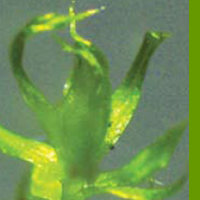1. W. Larcher. Physiological Plant Ecology, 4a ed. Berlín: Springer, 2003.
2. I. Kranner, R. Beckett, A. Hochman, T. H. Nash III. “Desiccation- Tolerance in Lichens: A Review”. The Bryologist, 111, (2008): 576-593.
3. M. A. Jenks, A. J. Wood, eds. Plant Desiccation Tolerance. Oxford: Blackwell Publishing, 2007.
4. M. J. Oliver et al. “Desiccation Tolerance in Bryophytes: A Reflection of the Primitive Strategy for Plant Survival in Dehydrating Habitats?” Intgr Comp Biol., 45, (2005): 788–799.
5. Y. L. Qiu et al. “The Deepest Divergences in Land Plants Inferred from Phylogenomic Evidence”. PNAS, 13, (2006): 15511-15516.
6. M. R. Crosby, R. E. Magill, B. Allen, S. He. “A Checklist of the Mosses”. St. Louis: Missouri Botanical Garden, 1999.
7. B. Crandall-Stotler, R. E. Stotler. “Morphology and Classification of the Marchantiophyta”. En A. J. Shaw, B. Goffinet, eds. Bryophyte Biology. Cambridge: s/casa editorial, 2000.
8. J. D. Mauseth. Botany: An Introduction to Plant Biology, 4a. ed. Boston: Jones and Bartlett Publishers, 2009.
9. P. Bhatnagar-Mathur, V. Vadez, K. K. Sharma. “Transgenic Approaches for Abiotic Stress Tolerance in Plants: Retrospect and Prospects”. Plant Cell Reports, 27, (2007): 411-424.
10. M. J. Oliver et al. “The Evolution of Vegetative Desiccation Tolerance in Land Plants”. Plant Ecol., 151, (2000): 85-100.
11. L. R. Stark et al. ”Generational Differences in Response to Desiccation Stress in the Desert Moss Tortula inermis”. Annals of Botany, 99, (2007): 53-60.
12. B. Vinocur, A. Altman. “Recent Advances in Engineering Plant Tolerance to Abiotic Stress: Achievements and Limitations”. Curr Opin Biotechnol., 16, (2005): 123-132.
13. T. Dobzhansky. “Nothing in Biology Makes Sense Except in the Light of Evolution”. The American Biology Teacher, 35, (1973): 125-129.
14. A. Bennici. “A Fundamental Plant Evolutionary Problem: The Origin of Land-Plant Sporophyte; Is a New Hypothesis Possible?” Riv Biol., 98, (2005): 469-80.
15. M. C. F. Proctor, M. J. Oliver, A. J. Wood, P. Alpert, L. R. Stark, N. L. Cleavitt, B. D. Mishler. “Desiccation-Tolerance in Bryophytes: A Review”. The Bryologist, 110, (2007): 595-621.
16. S. A. Rensig et al. “The Physcomitrella Genome Reveals Evolutionary insights into the Conquest of Land by Plants”. Science, 319, (2008): 64-69. |
 |